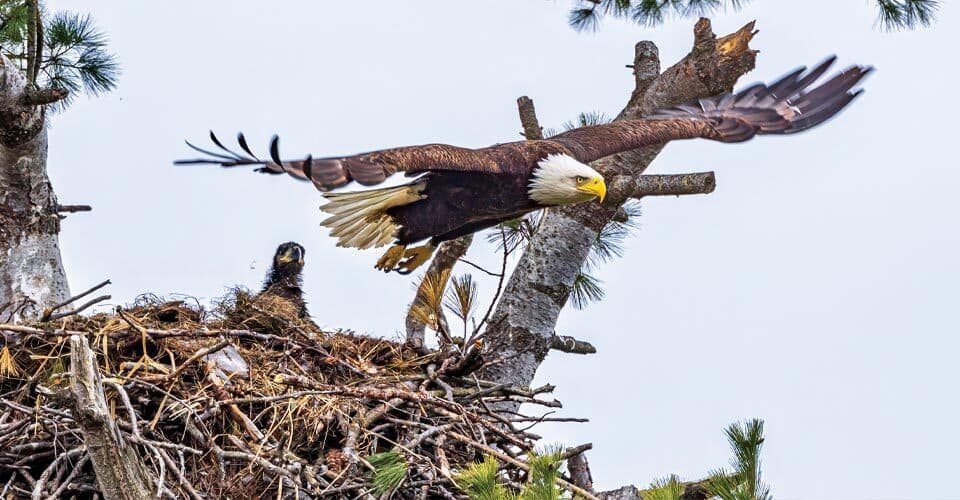A Soaring Success
Bald Eagle Expert Joins Legendary Explorers Club Honorees
By Karen Shih ’09
Eagle photo by Kathy Koenig
Headshot courtesy of Bill Bowerman
Apollo 11 astronaut Buzz Aldrin. Everest conqueror Edmund Hillary. Titanic discoverer Bob Ballard.
Now, environmental science and technology Professor Bill Bowerman joins their ranks as a 2023 recipient of the Lowell Thomas Award from the Explorers Club, founded more than a century ago to honor groundbreaking scientific field work.

Since 1986, Bowerman has kayaked down rivers, flown in helicopters and climbed trees—some more than 10 stories tall—to find bald eagle nests and collect data on population health and environmental contaminants. Thanks in part to his work, the bird has soared back from the brink of extinction and now inhabits 49 states. He’s also lent his expertise to raptor researchers worldwide.
He spoke to Terp about the first time he encountered America’s national bird, why they’re a “canary in a coal mine” for environmental health and the new threat of avian influenza.
Why bald eagles?
I grew up in a very small town on Lake Superior, surrounded by forests. I’d hunt with my uncles for ruffed grouse each fall. When I was 16, we were out in Michigan’s Upper Peninsula, and I saw a bald eagle perched on a tree. That was it. I wanted to understand: Why was this the first time I had seen one? Where I grew up, there should have been lots of them.
What was the state of the population in 1986?
We didn’t know if there were going to be bald eagles in 2000. Since the 1950s, chemicals like DDT and PCBs had caused thin shells and deformed chicks. DDT was banned in 1974 but lingered in the ecosystem. Even after a decade, the population hadn’t rebounded.
What’s a day in the field like for you?
Bald eagles primarily eat fish, so I’ll trudge through gnarly swamps to get to the nesting sites, which we find by aerial surveys. A team member will climb the tree, then carefully hook the nestling by its legs to put it into an eagle bag. We bring it down to band it and take samples of blood and feathers to test for mercury and other contaminants—eagles, as top predators, are good indicators of the health of the environment—then put it back and repeat.
How is climate change affecting bald eagles?
They’re nesting earlier. In the 1960s, researchers banded chicks in mid-June. Now, we go out on May 1. Warming temperatures may also be causing them to shrink, because traditionally, they’re bigger where it’s colder, like in Alaska. Eagles have adjusted so far, but continuing climate change could burn their forest habitats, change the available prey or cause heat stress.
What’s happening with avian influenza?
In 2022, 37% of the bald eagle mortalities in Michigan were from avian influenza. It’s a grave impact. I’m working with a population modeler to understand how much. Did we lose a year? Five years? A decade? That’s the only thing in 39 years in the field that’s scared me.
0 Comments
Leave a Reply
* indicates a required field

